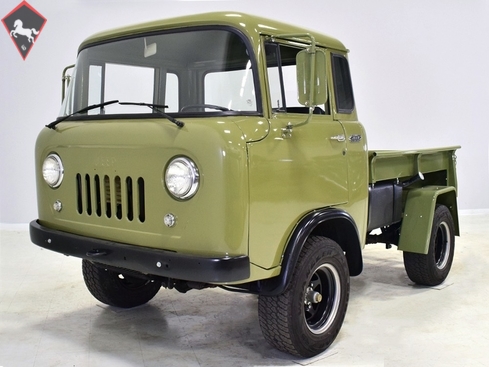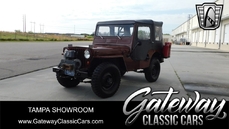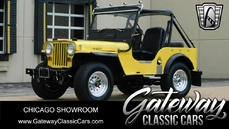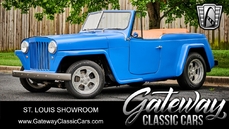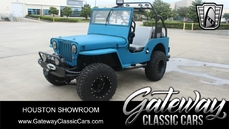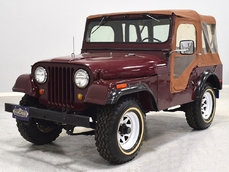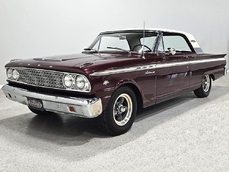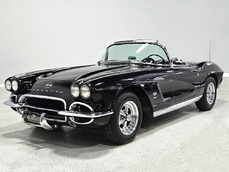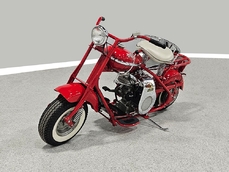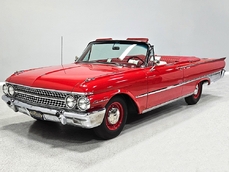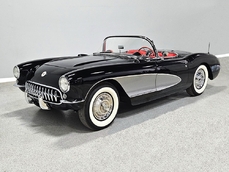Willys Jeep 134 cubic inch inline-4 1961
General description :
In the 1950s, automakers were still willing to color outside the lines, and few were more daring than the Willys Corporation. Existing on the edge of the industry with a lineup of military and commercial vehicles, plus variations adapted for consumer use, they were innovative in a way we can’t really imagine today. Designed by noted industrial designer Brooks Stevens, the Forward Control trucks were intended to deliver full-sized practicality in a much more maneuverable package and in that regard they were a huge success. Trucks like this 1961 Willys Jeep FC150 could carry as much as a full-sized ½-ton pickup but had a footprint barely larger than a 2-seat Nash Metropolitan. Yeah, no kidding! Combined with rugged mechanicals, go-anywhere 4-wheel-drive, and distinctive Jeep looks, it was a clever idea that never quite caught on. Aside from duty in the parks service and on ranches out west, the extreme cab-forward seating position never really caught on with consumers. Only about 30,000 were built during nine years of production, making them a real rarity today.
This handsome late-production FC150 pickup is the smaller of the two variations (with the other being the FC170) and it is the more popular version with today’s enthusiasts. It’s sized right to be a lot of fun and since it was loosely based on the CJ5, it has the same go-anywhere ruggedness you’ve come to expect from Jeep. It features a high-quality restoration of a fairly solid truck (restoration photos show only the lower doors needed work) and it’s 100% ready to enjoy today. It’s worth noting that the entire bed was re-created from scratch using a few of the original support braces to make it look right and it has never done a day of work since completion. The olive green finish is certainly appropriate on the cheerful little truck, although most were bright red, and we’re tempted to stick a big white star on its doors to complete the look. Finish quality is surely better than new, although not perfect—that wasn’t the goal and making it perfect would remove your temptation to get it dirty. New fenders were fabricated and mounted a little lower on the box just to make it look right and putting them back to the stock position requires nothing more than a pair of wrenches, although we suspect you won’t bother. The tailgate includes correct badging as well as two simple taillights above a bumper so crude that it makes you smile.
Inside, it’s definitely bare-bones. Twin bucket seats are perched atop the fender wells and wrapped in textured black vinyl that helps keep you cool on warm days. The door panels were upholstered to match, which is a nice touch, and this truck is fully optioned: heater and turn signals. If you’ve driven a city bus or a VW van, the driving position will feel familiar, although it does require a little acclimation to realize you’re sitting on top of the front wheels, and as a result it is extremely maneuverable. The big wheel makes it relatively easy to handle, although you want to keep it rolling a little bit to reduce effort. Controls are limited to the shifters in the center for the 3-speed manual transmission and transfer case, a few knobs for headlights and wipers (now electric instead of vacuum), plus a switch for the big electric fan up front that is designed to help keep it cool in parades. You also get a mammoth Willys heater on the firewall and it’s probably potent enough to roast a Thanksgiving turkey. The factory gauges covered the basics, and someone has added a set of vintage Stewart-Warner dials under the dash and they look appropriate (for some reason the fuel gauge reads in reverse—keep that in mind!). The doghouse between the seats houses the sturdy little Jeep 4-cylinder engine, with a flip-up door for easy access to the vital things like oil and coolant fillers and the dipstick. It’s definitely minimalist, but it’s also quite nicely done.
For power, it uses Willys’ rugged 134 cubic inch F-head inline-4. For those of you unfamiliar with this engine or an “F-head” configuration, it uses overhead valves for the intake side and valves in the block flathead-style for the exhaust. Surely they had their reasons for doing it that way, and we can’t argue with the way it works. It makes gruff, no-nonsense noises and it’s torquey enough to work with the rather short gears in the differentials to make it feel peppy around town and off road. It’s also bulletproof reliable, fully rebuilt, and completely stock, so it works like it should. It starts easily with a little choke, and if you’ve got the time this little truck will take you anywhere you want to go. Thanks to the aforementioned electric fan working in conjunction with the engine-driven fan, it stays nice and cool and there are custom vents on the back of the cab to help exhaust engine heat to control temperatures in the cabin. It works better than you’d expect and will outlast us all!
The T90 3-speed manual transmission should feel familiar to Jeep fans, and it’s connected to a Spicer 18 transfer case, which feeds power to the Spicer 25 front axle and Dana 44 rear axle. Gears are 5.38s, so it wasn’t built for speed, but it will cruise happily at 45-50 MPH and in low range it can climb a wall at little more than idle speed. If you’re brave enough to take it off-roading, you’ll quickly discover that this little truck can do things you couldn’t imagine in today’s giant 4x4s. There are skid plates protecting the vitals, a new exhaust system, new shocks, and a freshly restored gas tank hanging on the side. In addition, the brakes have all been rebuilt and it stops rather well given its modest performance, and yes, it does still have that 250-pound chunk of cast iron hanging under the rear tailgate designed to keep it from planting itself on its nose (whether it is necessary is debatable, but the government made them install it). The wheels and tires are modern, including the somewhat oversized 235/75/15 Goodyear Wrangler radials, but they look great and really do improve the ride. The spare is an NOS 6.70-15 Goodyear bias-ply on an original wheel, just because it looks right there in the tire well on the side.
This neat little truck brings a smile to everyone’s face when they see it and its eager personality and funky driving style make it unique among almost everything else you’ll ever drive. Jeep recently built a show vehicle based on the Forward Control and it was a major hit, and we’ve found that this modestly-priced 4x4 will be the star of almost any show it attends. Add in the fact that it’s still practical and you’ll always have the only one at any event, and you end up with something special. Hard to imagine having more fun than this in an old vehicle. Call today!
http://www.harwoodmotors.com/vehicles/inventory_details.php?id=1056
1961 Willys Jeep 134 cubic inch inline-4 is listed sold on ClassicDigest in Macedonia by for Not priced.
Car Facts
Car type : Car Make : Willys Model : Jeep Model Version : 134 cubic inch inline-4 Engine size : 0.0 Model Year : 1961 Sub type : Pick up Location : Ohio
Sold
Seller Information
Sold
People who viewed this Willys Jeep also viewed similar Willys listed at ClassicDigest
Other cars listed for sale by this dealer
About Willys
The Willys-Overland Company, later known simply as Willys, was an American automobile manufacturer that played a significant role in automotive history. Here's an overview of the story of Willys:Early Years:
Founding: The company was founded by John North Willys in 1908 in Toledo, Ohio, initially as the Willys-Overland Motor Company. John Willys acquired the Overland Automotive Division of Standard Wheel Company, which produced the Overland automobile.
Early Success: Willys-Overland experienced success in the early 1910s, producing vehicles like the Overland Model 79, which was a popular car due to its affordability and reliability.
World War I:
Military Contracts: During World War I, Willys-Overland secured significant contracts to supply vehicles for the war effort. The company's production capabilities were crucial for the military, producing trucks and automobiles for various purposes.
Introduction of the Jeep:
WWII Contribution: In the build-up to World War II, Willys-Overland, along with other automakers, responded to the U.S. Army's request for a lightweight, all-terrain reconnaissance vehicle. The company developed the Willys MB, which became the iconic Jeep.
Jeep Legacy: The Jeep, with its ruggedness, versatility, and reliability, played a crucial role in World War II. Its success led to the establishment of the Jeep brand, known for producing off-road vehicles that gained popularity in both military and civilian applications.
Post-War Period:
Civilian Jeep Models: After the war, Willys introduced civilian versions of the Jeep, like the CJ (Civilian Jeep) series, which were adapted from the wartime Willys MB. These vehicles became popular for off-road and recreational use.
Willys' Evolution and Later Years:
Ownership Changes: Willys-Overland faced financial difficulties and changed ownership several times in the post-war years, eventually becoming the Kaiser-Jeep Corporation after being acquired by Kaiser Motors in the 1950s.
End of Willys: In 1970, the American Motors Corporation (AMC) acquired Kaiser-Jeep. The Willys nameplate gradually faded away as AMC focused on the Jeep brand. Later, Chrysler acquired AMC in the 1980s and continued the production and development of Jeep vehicles.
Legacy:
Willys' legacy is primarily associated with its contribution to the automotive industry through the creation of the Jeep, a vehicle that transformed mobility during World War II and became an iconic brand in its own right. The Jeep's reputation for durability, versatility, and off-road capability originated from the innovations and success of Willys-Overland during wartime.
